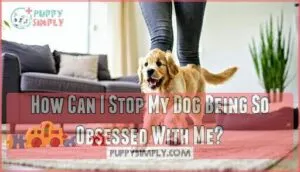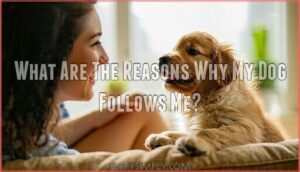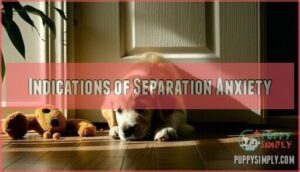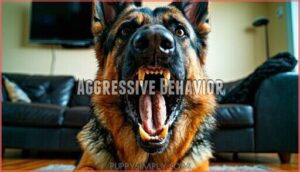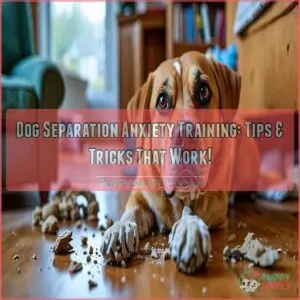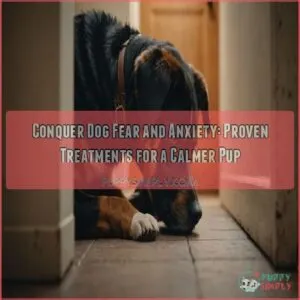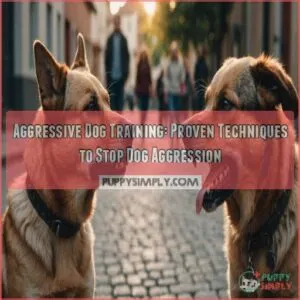This site is supported by our readers. We may earn a commission, at no cost to you, if you purchase through links.
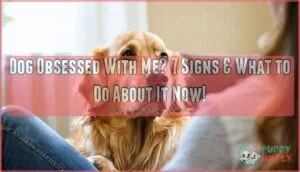
This intense attachment often stems from anxiety, breed traits, or reinforcement patterns you’ve unknowingly created.
While it feels flattering when your pup can’t bear to leave your side, excessive obsession can signal deeper issues like separation anxiety or insecurity.
Some dogs naturally cling more due to their breeding as companion animals, but constant whining, destructive behavior when alone, or refusing to settle without you nearby crosses into problematic territory.
The good news? You can address this behavior with patience and the right approach.
Table Of Contents
- Key Takeaways
- What Does It Mean When Your Dog is Obsessed With You?
- How Can I Stop My Dog Being So Obsessed With Me?
- My Friend’s Dog is Obsessed With Me
- My Dog is Obsessed With Being Petted
- What Are The Reasons Why My Dog Follows Me?
- How Does Following Me Benefit My Dog?
- How Will I Know if My Dog’s Following Has Gone Too Far?
- Frequently Asked Questions (FAQs)
- What does it mean if your dog is obsessed with you?
- Why do dogs become obsessed with their owners?
- Why is my dog so fond of being petted?
- Why is my rescue dog obsessed with Me?
- How do I know if my dog is obsessed with Me?
- Is having a dog obsessed with you a good idea?
- How Can I Tell if My Dog is Obsessed With Me?
- How Can I Get My Dog to Stop Following Me Everywhere?
- Is It Normal for My Dog to Follow Me Everywhere?
- How Can I Tell if My Dog Has Separation Anxiety?
- Conclusion
Key Takeaways
- Recognize the difference between normal attachment and problematic obsession – Your dog’s "velcro" behavior is a natural pack instinct, but if they cannot function independently, show destructive behavior when alone, or display separation anxiety symptoms, you are dealing with an issue that needs addressing.
- Understand the root causes driving your dog’s clingy behavior – Whether it is breed traits (herding dogs naturally stick close), reinforcement patterns you have created, boredom, trauma from rescue backgrounds, or medical issues, identifying the underlying cause helps you address it effectively.
- Set healthy boundaries through gradual independence training – You can reduce excessive following by rewarding calm behavior when your dog stays put, ignoring attention-seeking clingy behavior, providing mental stimulation through puzzle toys, and gradually increasing alone time.
- Watch for red flags that signal professional help is needed – If your dog shows aggressive behavior, destructive tendencies, excessive vocalization, house training regression, or panic responses when you are away, do not wait it out – consult your veterinarian or a professional behaviorist for proper intervention.
What Does It Mean When Your Dog is Obsessed With You?
When your dog seems glued to your side and can’t bear to be apart from you, it typically means they view you as their pack leader and primary source of security.
Your dog’s constant companionship isn’t just love—it’s their instinctual way of staying close to their trusted pack leader for security and guidance.
This behavior stems from their natural instincts as social animals who form strong bonds with their human family, though it can sometimes cross the line from affection into anxiety-driven attachment.
Reasons for Dog Obsession
Several factors drive your dog’s obsession with you.
Pack mentality makes dogs naturally seek their leader for security and guidance.
Breed predisposition plays a role – herding breeds like Border Collies show stronger velcro dog tendencies.
The boredom factor kicks in when dogs lack mental stimulation, leading to clingy behavior.
Trauma history from rescue dogs creates attachment issues and separation anxiety.
Medical causes like cognitive decline can trigger sudden obsession.
Understanding these roots of dog attachment helps you address your pup’s following behavior effectively, considering factors like pack mentality.
Sudden Onset of Obsession
Noticing your dog’s sudden shift from independent to shadow mode can feel alarming. When a previously well-adjusted pup develops dog clingy behavior overnight, it’s often a trauma response or anxiety spike triggered by environmental changes.
Moving homes, losing a family member, or welcoming a new baby can create a loss trigger that sends your dog into over attachment mode. Medical causes shouldn’t be overlooked either. Pain, neurological issues, or skin conditions can drive sudden changes in behavior before age two, potentially developing into lifelong dog separation anxiety patterns.
Your once-confident companion might now follow you everywhere, displaying intense dog attachment that feels overwhelming. Dogs are, by nature, social animals that enjoy human companionship.
Don’t panic though. This sudden onset often signals your dog needs extra security during a stressful period. Identifying the trigger—whether emotional upheaval or physical discomfort—helps you address the root cause effectively.
Obsession With Hands
When your dog constantly seeks out your hands, you’re witnessing a fascinating blend of affection vs obsession. Dogs naturally associate hands with food, treats, and comfort, making hand interaction irresistible.
Hand licking often signals love, but excessive hand nipping crosses into obsessive behavior territory. Your pup’s hands obsession stems from powerful food association memories.
Those same hands that deliver dinner and belly rubs become magnets for attention seeking. While gentle pawing and occasional licks show healthy bonding, persistent hand-focused behavior might indicate deeper dog obsession issues.
Watch for red flags: compulsive hand licking, aggressive nipping, or distress when hands aren’t available. These medical concerns warrant veterinary attention.
The sweet spot? Your dog enjoys hand contact without becoming frantic about it. If your furry friend can’t function without constant hand access, it’s time to establish healthier boundaries through training.
How Can I Stop My Dog Being So Obsessed With Me?
Why is your furry shadow constantly underfoot? Breaking free from dog over attachment starts with smart boundary setting and behavior modification. Your pup’s clingy behavior isn’t love—it’s learned dependence that needs reshaping.
Here’s your game plan for reducing dog constant attention:
- Increase Independence – Start with short separations, rewarding calm behavior
- Mental Stimulation – Puzzle toys keep minds busy when you’re not around
- Ignore Attention – Don’t reward following with pets or treats
- Schedule vet visits – Rule out medical issues causing sudden changes
- Professional Help – Contact behaviorists for extreme cases
Sudden clinginess can also be due to underlying health issues.
My Friend’s Dog is Obsessed With Me
When your friend’s dog shows constant attention toward you, it might trigger jealousy or awkward guest etiquette moments.
From the dog’s perspective, you represent something new and exciting. Don’t worry about the owner’s feelings – this temporary obsession happens frequently.
The dog obsessed with me behavior often stems from your unfamiliar scent or energy. This dog needy phase usually passes once novelty wears off.
Over attachment to guests is common, especially if you’re particularly affectionate. Dogs may exhibit this behavior because of pack mentality instincts.
Keep interactions calm and let your friend handle any corrections needed.
My Dog is Obsessed With Being Petted
Excessive petting obsession in your dog might signal deeper issues like separation anxiety or attention-seeking behavior. While dog affection and cuddles strengthen your bond, constant demands for attention can become problematic.
Some dogs develop growling sensitivity when touched, which isn’t aggression but overstimulation. A growl can be a communication tool to express discomfort.
Here’s how to manage petting obsession effectively:
- Redirect excessive requests to interactive play or brain games
- Establish petting schedules to create boundaries around dog attention
- Address stranger rambunctiousness through consistent training sessions
- Monitor for medical issues that might increase attention-seeking behavior
- Use positive reinforcement to reward calm, independent behavior instead
What Are The Reasons Why My Dog Follows Me?
Your dog’s constant following stems from several key factors that make perfect sense once you understand them.
Whether it’s reinforcement from your reactions, natural breed instincts, or simply craving your companionship, there’s usually a clear reason behind this shadow-like behavior.
Reinforcement
Your furry companion learns through positive reinforcement and reward systems that following you pays off.
Every time you give attention, treats, or affection when they shadow you, you’re accidentally creating a Positive Association.
Think of it like this: your dog’s brain says, "Following human equals good things happening!"
Reward Schedules matter too.
If you sometimes reward clingy behavior and sometimes don’t, you’re actually strengthening it through intermittent reinforcement.
Consistent Cues help, but many owners unknowingly reinforce obsessive following.
Shaping Independence requires Ignoring Behavior that’s attention-seeking.
Reward-based training works best when you reward your dog for staying put rather than following.
This teaches them that independence brings rewards too, creating a healthier balance in your relationship.
Breed Traits
Your pup’s genetics play a huge role in their following behavior.
Herding breeds like Border Collies and Australian Shepherds naturally stick close to manage their "flock" – that’s you!
Toy breeds such as Yorkies crave constant companionship, while guarding breeds like German Shepherds follow to protect.
Terrier traits include fierce loyalty and intense bonds with their humans, which are a result of centuries of selective breeding that mean some dogs are simply hardwired for devotion.
Companionship
Dogs naturally crave companionship because you represent their entire social world.
The human-animal bond runs deeper than simple pet ownership – it’s built on mutual affection needs and emotional security that both of you share.
Your dog’s pack mentality means they see you as their chosen family member.
This creates an intense bond that goes beyond basic care.
They follow you because social interaction with you fills their emotional tank.
You’re not just feeding them; you’re providing the dog companionship they desperately need.
This dog loyalty isn’t clingy behavior – it’s their way of staying connected to their favorite person.
Your presence offers emotional support that makes them feel complete.
Dog bonding happens through shared experiences, daily routines, and those quiet moments together.
When your pup shadows your every move, they’re simply expressing their deep need for your companionship and connection.
How Does Following Me Benefit My Dog?
Following you around isn’t just cute behavior—it actually serves important purposes for your furry companion.
This following behavior stems from deep-rooted instinctual needs that benefit your dog’s wellbeing.
Here’s how your dog always near you creates positive outcomes:
- Pack Mentality – Your dog sees you as their leader, and staying close fulfills their natural desire to remain with their pack for guidance and direction.
- Security Blanket – You provide emotional stability during uncertain moments, helping your dog feel safe and protected in various situations.
- Routine Reinforcement – Following you helps establish predictable patterns that create structure and comfort in your dog’s daily life.
- Companionship – This dog intense bond satisfies their social needs as naturally social animals who thrive on connection and interaction.
How Will I Know if My Dog’s Following Has Gone Too Far?
While a loyal companion following you around seems sweet, there’s a clear line between normal attachment and problematic obsession.
You’ll know your dog’s following has crossed into unhealthy territory when they can’t function independently or show signs of panic whenever you’re out of sight.
Indications of Separation Anxiety
When does your dog’s devotion cross the line into dog separation anxiety? Several telltale signs indicate your furry friend has developed this challenging condition. Unlike normal clingy behavior, separation anxiety triggers intense panic when you’re away.
Watch for destructive behavior like chewed furniture, scratched doors, or torn cushions. Your dog isn’t being spiteful—they’re genuinely distressed. Excessive vocalization, including non-stop barking, whining, or howling, often accompanies their anxiety. Neighbors might complain about the noise, which signals a serious issue.
Potty accidents inside the house, despite being house-trained, frequently occur with separation anxiety. Anxious pacing near windows or doors shows your dog’s restless state. Some dogs experience loss of appetite, refusing meals when alone.
This separation anxiety guide helps distinguish normal attachment from problematic dog anxiety. A common symptom includes destructive chewing behavior. If your pup displays multiple symptoms consistently, consult your veterinarian. Early intervention prevents escalation and improves your dog’s quality of life. Remember, addressing these behaviors requires patience and often professional guidance.
Aggressive Behavior
When separation anxiety escalates, aggressive behavior becomes your biggest red flag. This isn’t your dog being "mean" – it’s fear and stress boiling over into dangerous territory.
Aggression isn’t meanness—it’s your dog’s desperate SOS when anxiety overwhelms their coping ability.
Trigger Identification is your first line of defense. Watch for these warning signs that aggression may be brewing:
- Resource guarding around food, toys, or even you
- Dominance displays like blocking doorways or stiff body language
- Fear aggression when cornered or overwhelmed by separation
- Redirected aggression toward other pets when you’re not available
Growling, snapping, or biting aren’t personality flaws – they’re your dog’s last resort when anxiety becomes unbearable. If your pup starts showing these behavior problems, don’t wait it out. Professional help prevents small issues from becoming dangerous situations. Many owners seek products for treatment when addressing aggression. Remember, an anxious dog isn’t a bad dog. They’re just overwhelmed and need your guidance to feel secure again.
Frequently Asked Questions (FAQs)
What does it mean if your dog is obsessed with you?
Your furry shadow’s practically glued to your hip because you’re their entire world rolled into one amazing package.
It signals deep love, pack instincts, or possible separation anxiety needing gentle boundaries.
Why do dogs become obsessed with their owners?
Pack instincts drive your pup’s obsession—you’re their leader and safety anchor.
Boredom, anxiety, or past trauma can intensify this behavior.
Strong emotional bonds, positive associations with food and play, plus your consistent love create their devoted attachment.
Why is my dog so fond of being petted?
Petting feels good, petting builds bonds, petting releases happy hormones.
Your dog craves those gentle touches because they trigger oxytocin and endorphins, creating pure bliss.
It’s their way of connecting with you emotionally and physically, which helps build a strong bond through gentle touches.
Why is my rescue dog obsessed with Me?
Your rescue dog’s obsession stems from past abandonment trauma and anxiety.
They’re clinging to you for security and emotional stability.
This behavior shows they’ve bonded deeply but need gradual independence training.
How do I know if my dog is obsessed with Me?
You’ll notice constant following, intense staring, whining when you leave, and inability to relax without you nearby.
Your dog becomes your shadow, panicking during separations and displaying clingy behavior that goes beyond normal affection.
Is having a dog obsessed with you a good idea?
Balance is key, boundaries matter, and independence counts.
While your dog’s devotion feels flattering, extreme obsession creates anxiety, stress, and behavioral problems.
You’ll both benefit from healthy attachment rather than overwhelming dependence that limits freedom and creates a need for balance.
How Can I Tell if My Dog is Obsessed With Me?
Your dog follows you everywhere, never leaves your side, stares intensely, whines when you’re gone, and can’t relax without you nearby. They’re basically your furry shadow who panics during separation.
How Can I Get My Dog to Stop Following Me Everywhere?
Breaking your shadow’s constant presence requires patience and strategy.
Gradually increase alone time, reward independence with treats, create physical boundaries using baby gates.
Ignore clingy behavior while providing engaging toys for distraction, to help your shadow develop independence.
Is It Normal for My Dog to Follow Me Everywhere?
Yes, it’s completely normal for your dog to follow you around.
Dogs are pack animals who view you as their leader and source of comfort.
This "velcro dog" behavior shows strong bonding and affection.
How Can I Tell if My Dog Has Separation Anxiety?
Up to 20% of dogs experience separation anxiety.
You’ll know if your dog panics when you leave, displaying destructive behavior, indoor accidents, or excessive barking.
Clingy dogs stay close but don’t panic when alone.
Conclusion
Remember, 73% of dog owners report their pets follow them to multiple rooms daily, making your experience completely normal.
When your dog obsessed with you displays healthy attachment, it strengthens your bond and provides mutual comfort.
However, crossing into separation anxiety territory requires immediate attention through gradual independence training and consistent boundaries.
You’ve got the tools to distinguish between loving devotion and problematic obsession, so trust your instincts, stay patient with the process, and celebrate small wins as your furry shadow learns healthy independence.

